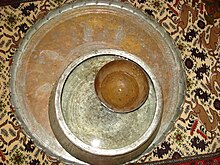Traditional water sources of Persian antiquity
[2] The Qanats mostly came in from higher elevations, and were split into a distributing network of smaller underground canals called kariz when reaching the city.
These underground aqueducts, built thousands of years ago suffer no evaporation loss and are ideally suited for drinking water since there is no pollution danger.
That is when some wealthy inhabitants started building private reservoirs called ab anbar (Persian آب انبار).
One of the oldest and largest known qanats is in the Iranian city of Gonabad which after 2700 years still provides drinking and agricultural water to nearly 40,000 people.
[8] Many of the Iranian qanats bear some characteristics which allow us to call them feat of engineering, considering the intricate techniques used in their construction.
According to Goblot, this innovation took place in the northwest of the present Iran somewhere bordering Turkey and later was introduced to the neighboring Zagros Mountains.
According to an inscription left by Sargon II the king of Assyria, In 714 BC he invaded the city of Uhlu lying in the northwest of Uroomiye lake that lay in the territory of Urartu empire, and then he noticed that the occupied area enjoyed a very rich vegetation even though there was no river running across it.
In fact it was Ursa, the king of the region, who had rescued the people from thirst and turned Uhlu into a prosperous and green land.
For example, following Darius's order, Silaks the naval commander of the Persian army and Khenombiz the royal architect managed to construct a qanat in the oasis of Kharagha in Egypt.
The most reliable document confirming the existence of qanats at this time was written by Polybius who states that: “the streams are running down from everywhere at the base of Alborz mountain, and people have transferred too much water from a long distance through some subterranean canals by spending much cost and labor”.
In a study by Russian orientalist scholars it has been mentioned that: the Persians used the side branches of rivers, mountain springs, wells and qanats to supply water.
As an instance, Arsac III, one of the Parthian kings, destroyed some qanats in order to make it difficult for Seleucid Antiochus to advance further while fighting him.
In Iran, the advent of Islam, which coincided with the overthrow of the Sassanid dynasty, brought about a profound change in religious, political, social and cultural structures.
The Persian historian Hamdollah Mostowfi writes: “Zobeyde Khatoon (Haroon al-Rashid’s wife) constructed a qanat in Mecca.
For example, according to the “Incidents of Abdollah bin Tahir’s Time” written by Gardizi, in the year 830 AD a terrible earthquake struck the town of Forghaneh and reduced many homes to rubble.
One can deduce from these facts that during the above-mentioned period the number of qanats was so considerable that the authorities were prompted to put together some legal instructions concerning them.
Later, in the era of the Ilkhanid dynasty especially at the time of Ghazan Khan and his Persian minister Rashid al-Din Fazl-Allah, some measures were taken to revive the qanats and irrigation systems.
The rich supply of groundwater and suitable geological-topographical conditions of Tehran allowed this city to house many qanats whose total discharge amounted to 2000 liters per second.
Haj Mirza Aghasi (ruling between 1834 and 1848), the prime minister of the third king of the Qajar dynasty, encouraged and supported qanat construction throughout the country.
Jaubert de Passa who surveyed the situation of irrigation in Iran reported a population of 50,000 in Hamedan, 200,000 in Isfahan and 130,000 in Tehran in the year 1840.
They had to pay rent for land and water to the landlords who could afford to finance all the proceedings required to maintain the qanats, for they were relatively wealthy.
The introduction of modern devices, that made it possible to drill many deep wells and extract groundwater much more quickly, accelerated the qanats’ destruction.
The main mission of this center is the recognition, transfer of knowledge and experiences, promotion of information and capacities with regard to all the aspects of qanat technology and related historic hydraulic structures.
This deficit in the volume of the aquifer reserves has led to a long-term groundwater level drop of 41 centimeters a year, on average.
A typical residential ab anbar would be located in the enclosed garden, have the capacity to hold 50 cubic meters, would be filled once every two weeks, and have its inside surfaces cleaned from sediments once a year (called layeh-rubi).
Soon public ab anbars were constructed throughout cities across Persia such as Qazvin, Yazd, Naeen, Kashan, Zavareh, Ray, Shiraz, Herat, Balkh, and others.
Water temperatures of Kashan’s famous Qanat of Chashmeh-i Soleiman amidst the July heat is typically around 25 degrees Celsius.
Furthermore, ab anbars tend to further lower the temperature of the water due to the fascinating heat resistance properties of the construction material used.
Near freezing temperatures of the water can readily be observed in the desert central city of Naeen during summer, inside an ab anbar that employs multiple windcatchers.
Explosive migratory trends in Iran in the past 30 years have led to a wave of hasty urbanization inside the old quarters of ancient cities, destroying their original fabric.




